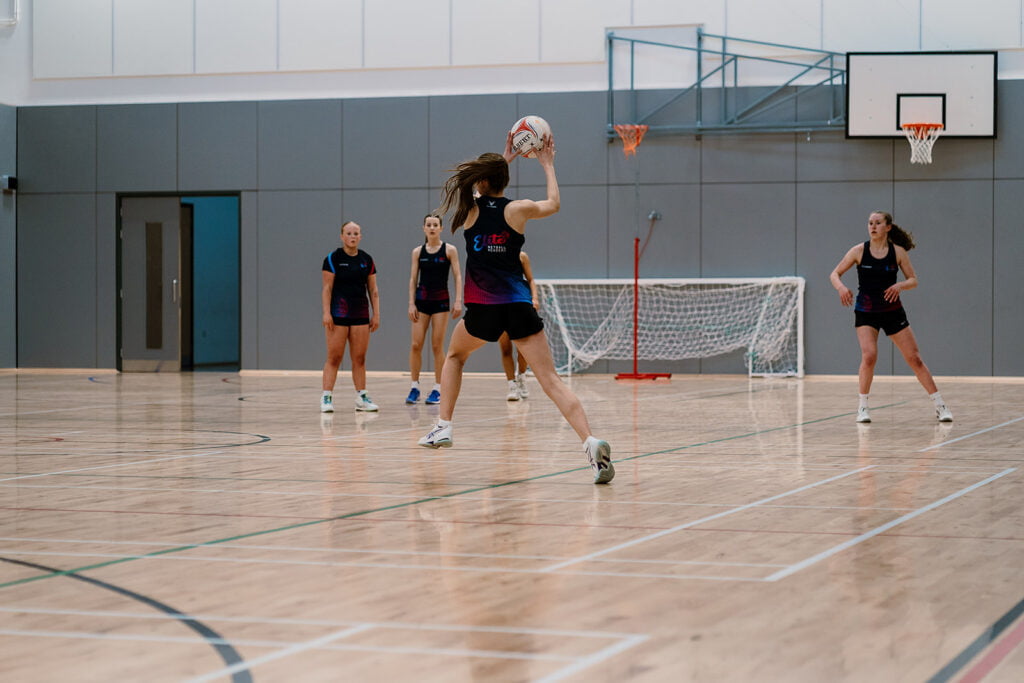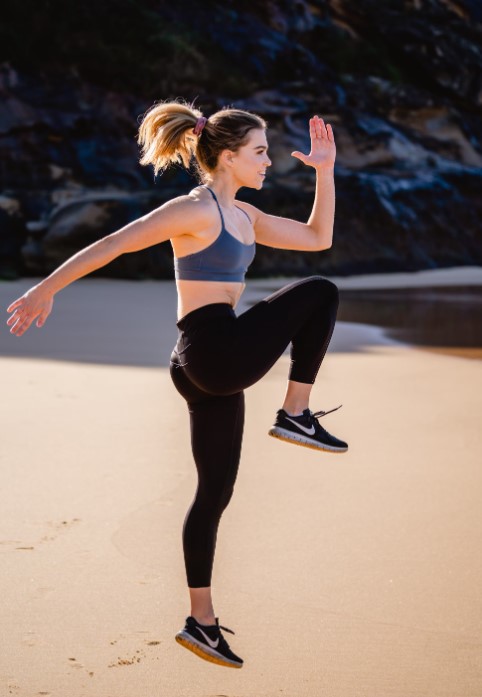In this article, we explore the significance of plyometrics for netballers and why it is crucial for their overall performance on the court.
Here are some quick links and what you can anticipate:
What is conditioning in netball?
Conditioning in netball is essential due to the dynamic nature of the sport, which requires explosive movements to outperform opponents and vie for possession of the ball. Building strength and power through conditioning prepares netballers to execute at their peak performance level.
Conditioned netballers possess the ability to execute balanced landings and withstand the impact of running, jumping, and landing on solid surfaces.
How plyometrics benefits netballers
Plyometrics, with its focus on quick and explosive movements like jumping and hopping, is an ideal conditioning exercise for netballers. These exercises help in developing muscle power and speed while enabling netballers to absorb force during the landing phases of jumps.
Utilizing the stretch-shortening cycle (SSC), plyometric training involves a rapid transition from a lengthening (eccentric) movement to a shortening (concentric) movement.
Plyometric activities can be categorized into fast movements and slow movements. For instance, the pogo jump represents a fast plyometric movement focusing on rapid floor clearance, while the broad jump signifies a slow plyometric movement without constraints on jump contraction.
Enhancing power is a critical physical attribute for netballers as it aids in quick acceleration to create space, challenge opponents, and change direction swiftly.
Importance of power in netball
Power is indispensable in netball for activities like leaping to block shots or sprinting to secure a loose ball and evade opponents. Upper body power is also vital for accurate passes and shots.
5 Advantages of plyometrics for netballers:
Power – Enhances the ability to generate force rapidly, translating into high jumps and swift movement off the ground.Speed – Improves the capacity to move swiftly and explosively.Agility – Enhances acceleration, deceleration, and reacceleration abilities to switch direction efficiently.Movement Competency – Teaches safe jumping and landing techniques, positioning the body for maximum power output while averting injuries caused by high forces.Balance – Executing unilateral jumps or swift directional changes necessitates maintaining stability and control. Plyometric training enhances the proprioceptive system, crucial for maintaining control during dynamic movements.

Can plyometrics prevent injuries?
Plyometrics offer injury prevention benefits by reinforcing joint and tendon strength to endure greater forces and stresses during physical exertion.
Recent research indicates that plyometric exercises may aid in the prevention of non-contact ACL injuries by enhancing the ability to land safely and evenly distributing forces across the body. A well-structured plyometric training regimen can enhance neuromuscular control in all three planes, minimizing ACL stress and transferring it to the muscles, tendons, and bones. This improved force distribution lessens direct force on the knee.
Current Concepts of Plyometric Exercises (Davies et al., 2015). Hewett et al. (1996)
How often should netballers engage in a plyometric workout?
Netballers are advised to include plyometric workouts into their routine 2 – 3 times weekly.
The frequency of these sessions depends on other training commitments during the week. It is recommended to allow at least one day of rest between plyometric sessions. These workouts can be combined with strength exercises as they complement each other. Usually, 2 – 4 plyometric exercises are incorporated per session and should be conducted at the beginning of the session due to their high-intensity nature.
Since plyometrics are high-intensity exercises that can exert significant stress on joints, tendons, and muscles, it is crucial to gradually increase the volume to minimize the risk of injury or overtraining, particularly for new exercises like plyometrics.
Volumes are managed differently from traditional gym-based exercises, with foot contacts (i.e., landing after a jump) being the key metric for plyometrics.
An average netball player performs around 1,000-to-1,500-foot contacts per 60-minute game (varies by playing position and style).
When adding plyometrics to training programs, it is essential to consider the training and match volumes already being experienced as some form of plyometrics is incorporated during regular training and gameplay through jumping and landing.

A low volume of 50-foot contacts during a training session is considered safe, while exceeding 200-foot contacts is deemed high volume, depending on exercise intensity.
Exercises like drop jumps and bounding, classified as high-intensity plyometrics, require lower volume, whereas low-intensity plyometrics like pogo jumps and skipping can be performed at higher volumes without excessive impact on the body.
The pre-season is an ideal period to focus on plyometrics alongside technical training to enhance movement competency, develop power and speed, and prepare the body for the physical demands of a lengthy season involving extensive jumping, landing, and turning.
5 Home-based plyometric exercises for netballers
1. Countermovement Jump
This power exercise entails jumping as high as possible following a rapid lower body bend and extension. It directly translates to on-court skills like jumping to reach or block.
No special equipment is required. Stand with your feet hip-width apart, bend your knees, and push down to generate power for a vertical jump. Reach upward with your arms, land in a squat position, and repeat as many times as possible in 30 seconds.
2. Double leg / single leg hurdle
This exercise is effective for developing horizontal unilateral and bilateral power. It aids in acceleration (quick start) and teaches proper landing and deceleration, which are essential for safe stops on the court.
Arrange hurdles in a line and jump over them one by one, using your arms for forward propulsion. Land evenly for double leg jumps and balanced for single leg hurdles. Move swiftly through the hurdles for maximum benefit from this plyometric drill.
Go through the hurdles and return to the start, repeating the sequence thrice before resting.
Tip: If hurdles are unavailable, utilize jumpers or water bottles (placed horizontally) as obstacles.
3. Pogos to land in different positions
This exercise enhances quick reflexes and agility, focusing on dorsiflexion and plantarflexion, landing on the midfoot for elasticity and ankle stability, crucial for stable landings in varying positions.
No equipment is needed. Stand on one foot and hop in different directions. When you land on a single foot, aim to maintain balance before pushing off. Repeat on both feet.
Try 30 seconds on each side, increasing repetitions as you progress.
Need more plyometric exercises for netballers?
Check out the remaining two exercises below:
Significance of activating muscles before exercise
Plyometric exercises are intense and demanding on the body; therefore, it is crucial to properly warm up before engaging in them.
A thorough warm-up reduces muscle soreness post-exercise. Follow the RAMP protocol:
Raise heart rateActivate musclesMobilise jointsPotentiate the body
(Potentiate means to enhance the effectiveness of something, ensuring the body is ready for plyometric exercises)
Activations should target the lower body, including the hip, knee, and ankle regions. Activating stretches, calf raises, and glute activation exercises are beneficial pre-plyometric workout. Low-intensity plyometrics can be included at the end of the warm-up to focus on movement competency, stability, and balance while enjoying the session.

Low-intensity plyometrics may include navigating a jump obstacle course, balancing on an object, or participating in jump-based games—get the body warmed up, moving, and having fun.
Importance of cooldown
Cooling down and recuperating after a plyometric session is crucial due to the intense nature of the exercises and strain on the body. Proper cooldown helps alleviate muscle soreness, shorten recovery time, reduce injury risk, and enhance flexibility and mobility through stretching.
If you have any doubts regarding the exercises discussed, consult with a coach or instructor before attempting them. Prioritize correct movement execution over intensity to ensure proper form before increasing complexity or intensity with more advanced plyometrics.






















